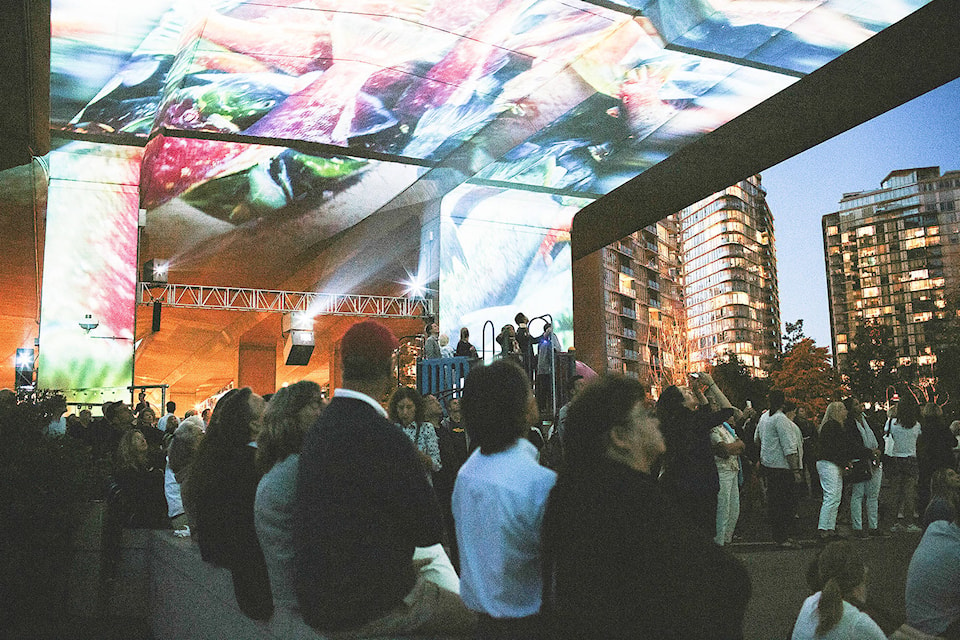For internationally acclaimed documentary filmmaker Nettie Wild, what she now describes as the artistic highlight of her life began during a Thanksgiving visit in 2010 to the Adams River sockeye salmon run.
It was a huge peak run, with close to four million sockeye completing their 600-kilometre journey from the Pacific Ocean to spawn.
“I was overwhelmed. It literally changed my life,” she says.
The fish inspired Uninterrupted, Wild’s cinematic spectacle that brought the salmon to the underbelly of Vancouver’s Cambie Street Bridge using what’s been described as a blend of cinematic storytelling and high-tech art installation. Underwater footage of Adams River salmon is projected on the underside and pillars of the bridge.
“It was incumbent on me not to be arrogant and think I could in any way duplicate that (the run). But to translate it and storytell it as an artist, to bring your art to it and see where it takes you,” she says. “It took me, and 130 other people who helped me make it, to a surprising place which was totally different again from the river, from the experience, but absolutely was inspired by the fish.
“The fish and bridge are what formed Uninterrupted.”
A soundscape accompanies the images, which includes the voice of late Neskonlith elder Mary Thomas, telling the story of the salmon in the Secwepemc language.
The free viewing of the spectacle took place five nights a week from June 28 to Sept. 24, where crowds gathered at Coopers’ Park.
It played to more than 30,000 people, she says, with many people coming back three or four times to take it all in.
During the final weekends from Labour Day on, more than 1,000 people watched each night, with 1,600 turning out the last night.
While Wild describes the making of Uninterrupted as the artistic highlight of her life, she admits that exhibiting it was just as thrilling. She estimates she attended about 40 of the 60 projections, not just for the wonder of it, but to learn from the audience.
“It was unbelievable to have this new relationship with the audience. Our piece was big, it was public and it was free.”
Because there was no formal seating – in fact Wild had envisioned the audience would stand for the 25-minute production – people would sit on the playground equipment in the park, lie on their backs on the ground and adapt other creative options.
“The audience had a mind of their own,” she laughs, explaining she learned much from bringing her art to a public place, rather than having the audience come to a gallery or theatre.
“It was a wonderfully bizarre place, with people lying down, having picnics, party boats going by, sirens going off. I really like the combination of that art in that urban space. Embracing the wild. It was a thrill…”
Wild was pleased that some members of the Thomas family were able to come watch Uninterrupted, a title which refers to the existence of the salmon’s cycle from time immemorial, uninterrupted.
Several First Nations were behind the project, including Little Shuswap and Neskonlith. The staff at Roderick Haig-Brown Provincial Park and the Adams River Salmon Society were also a huge help, she said.
Salmon Arm Mayor Nancy Cooper, returning from the Union of BC Municipalities convention in Vancouver last week, says she was thrilled to watch the production.
“Everyone in attendance that evening was wowed by the film, as was I. My thoughts as I walked back to our hotel were about how truly incredible the salmon cycle is and how well it was depicted in the video… And how important it is that we ensure the salmon continue to come back to this area and that their cycle remains uninterrupted.”
Wild says Uninterrupted was the most abstract thing she’s ever made.
“We could have done a lecture about the life cycle of the salmon, and I think that would have been dry and pedantic, and there wouldn’t have been wonder in it and we wouldn’t have had the crowds. Here we have turned on a whole bunch of people to the life cycle of the salmon in a much more delightful and subversive way, I think,” she says with a chuckle.
“The world is so full of facts and figures, and I think my tools are wonder and surprise and curiosity and beauty. If we’re able to use those well through cinema, then that’s what we can contribute.”
